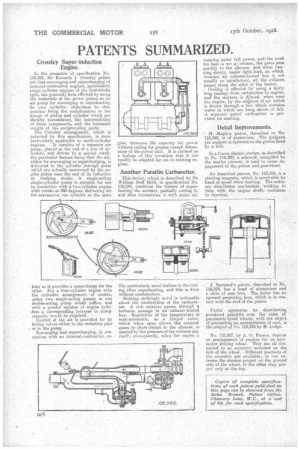PATENTS SUMMARIZED.
Page 22

If you've noticed an error in this article please click here to report it so we can fix it.
Crossley Super-induction Engine.
In the preamble of specification No. 118,362, Sir Kenneth I. Crossley points out that scavenging and supercharging of internal-combustion engines, particularly single-cylinder engines of the four-stroke type, has generally been effected by using the underside of the power piston as an air pump for scavenging or superheating its own cylinder, objections to • this practice. being the complications in the design of piston and cylinder which are thereby necessitated, the inaccessibility of these components, and the increased weight of the reciprocating parts.
The Crossley arrangement, which is patented by this specification, is more particularly applicable to multi-cylinder
engises. It consists of a separate air pump, placed at the end of a row of cylinders, and driven by a special crank, the particular feature being that the air, either for scavenging or supercharging, is delivered to the cylinder through ports which are actually uncovered by the engine piston near the end of its induction or working stroke. A single-acting single-cylinder pump is suitable for use in connection with a two-cylinder engine with cranks at 360 degrees, delivering air for scaven2ina one cylinder at the same
time as it provides a supercharge for the other. For a four-cylinder engine with the orthodox arrangement of cranks, either two • single-acting pumps or one double-acting pump would su.ffice, and with a greater number of engine cylinders a corresponding increase in pump capacity would be required. Control of the air is provided for by fitting valves either in the induction pipe or in the pump, Scavenging and supercharging, in connection with an internal-combustion en gine, increases the capacity for power without calling for greater overall dimensions of the power unit. It is claimed as a feature of this invention that it can readily be adapted for use in existing eugines.
Another Paraffin Carburetter.
This device, which is described by Sir William Duff Reid; in specification No. 1/8,340, combines the feature of superheating the mixture, partially cooling it, and then intermixing it with moist air.
The particularly novel feature is the cooling after superheating, and this is done without condensation.
Nothing strikingly novel is noticeable about the construction of the carburetter. A rich mixture passes through a tortuous passage in an" exhaust-heated box. Regulation of the temperature it semi-automatic, as a hinged valve, which when open allows the exhaust gases to short-circuit to the silencer, is opened by the pressure of the exhaust gas itself ; consequently, when the engine is running under full power, and the need for heat is not so intense, the gases pass quickly to the silencer, and when running slowly, under light load, on which occasion an exhaust-heated box is not usually so satisfactory, all the exhaust passes along the side's of the heater.
Cooling is effected by using a fairly long passage from carburdtter to engin-e, and the mixture is diluted, when near the engine, by the ackPion of icr which is drawn through a box Which contains water in which are hung sheets of felt. A separate • petrol carburetter is provided for starting.
Detail Improvements.
H. Hagin's piston, described in No. 118,342, is of aluminium. The gudgehn pin support is fastened to the piston head by a bolt. .
In a Lucas electric starter., as described in No. 118,220, a solenoid, energizied by the starter current, is used to cause engagement of the pillion and gearwheel.
An American patent, No. 118,318, is a starting magneto, which is revolvable by hand at speed when starting. The ordinary distributer mechanism, working in time with the engine shaft; continues to function.
J. Burnand's piston, described in No. 118,322, has a head of aluminium and a skirt of cast iron. The.latter has an upward projecting boss, which is in contact with the roof of the piston.
Useful apparatus for distributing powdered graphite over the rims of pneumatic-tyred wheels, with the object of preventing an accumulation of rust, is the subject of No. 118,344 by H. Lodge.
No. 118,387, by A. -0. Parson, depicts an arrangement of strakes for an. agrimotor driving wheel. They are all connected to an eccentric mounted on the • hub of the wheel. Different positions of the eccentric are available ;. in one extreme the strakes project on. the ground side of the wheel, in the other they project only at the top.






















